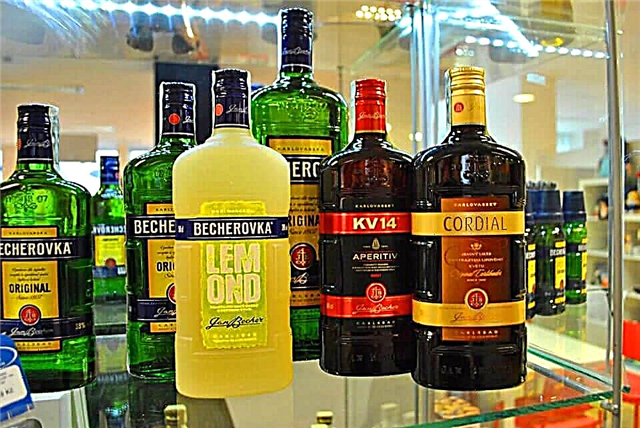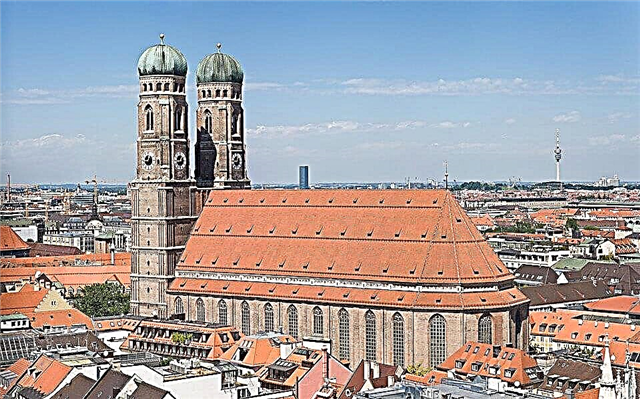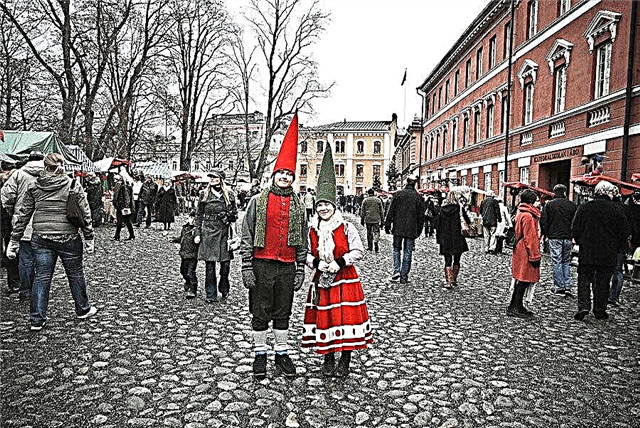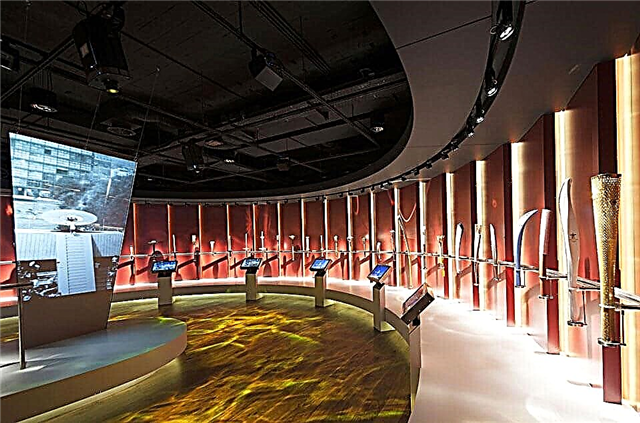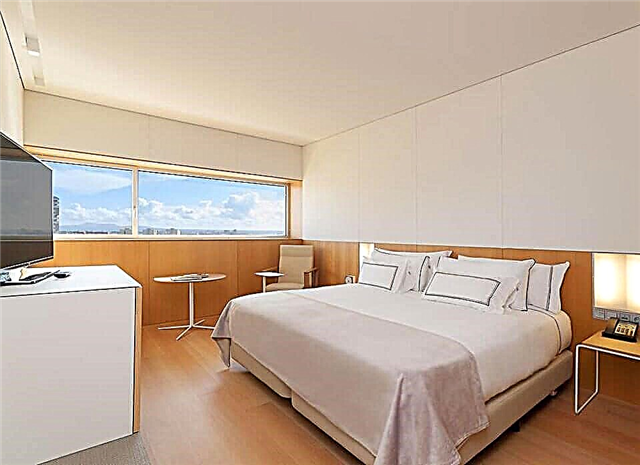Yaroslavl has always and in everything remained the first - the first Orthodox city in Russia, the city in which the first bookstore, the first theater opened, the first Russian tram went, and for the first time a local magazine began to be published. And in terms of the number of monuments of history and art, it is also, perhaps, the first. There are so many of them that it would be enough for several cities.
It is almost impossible to see all the main treasures of Yaroslavl in one day. Therefore, we have chosen the most interesting for you, fortunately, almost all of them are located nearby, literally within walking distance from each other. So, we will tell you what to see in Yaroslavl in one day on your own.
Church of St. John Chrysostom in Korovniki

The temple complex in Korovniki is visible from afar. The Church of St. John Chrysostom - its foundation - is not accidentally considered one of the main monuments of ancient Russian architecture. It embodied the dream of its creators to strive for perfection and harmony. The beauty of nature and the perfection of architectural forms are combined here with special strength.
The temple was built in the middle of the 17th century at the confluence of the Volga and Kotorosl rivers at the expense of wealthy townspeople - Fedor and Ivan Nezhdanovsky (here, in the southern gallery of the church, their graves are located). The five-domed temple with two hipped roofs, wide galleries surround with high porches.
The uniqueness of the church lies in its decoration, or rather its absence: thanks to skillful red brick masonry, the temple looks very elegant even without special paintings and decorative details.
By the end of the century, window frames were decorated with carvings, and painted tiles appeared in the masonry. Inside, the church was painted only in the 18th century by the famous team of Alexei Soplyakov. At the same time, a five-tiered iconostasis was installed here - a true masterpiece of world painting.
Today the temple is run by the Old Believer Church. Services are held here and restoration work is underway.
Temple of the Vladimir Icon of the Mother of God

At the beginning of the 17th century, a wooden chapel stood on the Yaroslavl "Bozhedomka" (a cemetery where vagabonds, drowned and unknown wanderers were buried).
In its place in the 70s, it was decided to build a stone church. A wealthy merchant, Semyon Afanasyevich Luzin, allocated funds for this. The builders of the temple decided to erect it with three tent-roofed heads, despite the prohibition by Patriarch Nikon on the construction of tent-roofed churches in force at that time.
Thanks to this, the temple becomes the final element of the most important period in the history of ancient Russian art. As befits a cemetery church, it has strict forms and laconic external and internal decoration.
At the end of the 18th century, everywhere all the houses were abolished, and gradually a residential quarter grew here. The cemetery was moved across the river, in its place in the 19th century the Vlasyevsky garden was laid out, and a bell tower was attached to the church. Gradually, it became a favorite resting place for the townspeople. In the Soviet years, the temple housed warehouses, and only in 1992 it was returned to the Orthodox Church.
Arrow

This is where the city begins. Moreover, both historically and geographically. Here, at the confluence of the Volga and Kotorosl, the first settlements appeared in the 9th century. And 100 years later, in 1010, Yaroslav the Wise sailed along the Volga.
According to legend, here he killed a bear with a spear, the tip of which exactly repeats the outline of the coast. It was then that the prince decided to found a city here. The first temple and the old Kremlin - the so-called Chopped City, repeating the shape of the cape - were erected on the arrow.
In honor of the 1000th anniversary of Yaroslavl, a monument was erected on Strelka - a 20-meter stele with a double-headed eagle, at the base of which sculptures of Yaroslav the Wise, Yaroslavna, priests, chroniclers and soldiers who defended these lands, bas-reliefs on the pedestal also illustrate the most striking events in the history of the city.
Strelka is a favorite place for townspeople and tourists. The best views of all city attractions open from any point on it.
Church of John the Baptist

This temple is known even to those who have never been to Yaroslavl. In 1997, his image appeared on a 1,000-ruble note. And even earlier, V. Vereshchagin immortalized him in his painting “Yaroslavl.
The porch of the Church of St. John the Baptist in Tolchkovo. In the middle of the 17th century, a huge fire broke out in Yaroslavl. He destroyed a lot of residential buildings, 3 monasteries and almost 30 churches.
After the fire, the townspeople quickly rebuilt their hometown. The residents of Tolchkovaya Sloboda decided to build a new one instead of the burnt down wooden church. They built it all over the world: people carried money, valuable ancient icons, gold and silver jewelry and ingots, someone worked at the construction site for free.
For the construction of the temple, two brick factories were even opened. Due to a complex architectural solution, the construction was delayed for 16 years.
Immediately after its consecration and throughout its history, the temple was known for its trusteeship and charitable deeds. From the first days there was an almshouse at the church, and in the 19th century there was a parish guardianship and a school, which was later transformed into a women's school.
There was an orphanage for girls, a sewing workshop and a laundry worked, and a circle was organized where the workers of the Big Manufactory were taught to read and write. After the revolution, the church building housed warehouses, a smithy and a dining room. And only the intervention of Glavnauki saved the temple from complete destruction.
Now it is under the protection of UNESCO, scientific and restoration work is being carried out here.
Church of St. Michael the Archangel

Back in 1215, on the bank of Kotorosl, Prince Konstantin ordered to erect a wooden church in memory of the soldiers who fell for the Russian land. In honor of the patron saint of all serving people - Michael the Archangel, the temple was consecrated. The church stood for almost 400 years, and only in the 17th century a stone church began to be built in its place. Construction has been going on for 25 years, money for which was collected by the people.
This is what explains the mixing of medieval architectural style with later architectural traditions - large windows, high drums. The peculiarity of the church is the unusual house-like porch.
The interior of the temple was painted by the artist Fyodor Fedorov. During the Soviet years, the church was closed. It was restored only for the celebration of the 1000th anniversary of Yaroslavl. Now the festival of bell-ringing art "Transfiguration" is held here every year.
Church of the Savior on the City

Another temple, the history of which is closely connected with the beginning of the city. Here, on the banks of the river, which served as the border of the Chopped City, there were trade rows, and life was always in full swing.
The wooden Church of the Savior has stood here since the 13th century. During a fire in 1658, it burned down. By this time, the city had already recovered from the devastation of the Polish-Lithuanian conquerors, and it was decided to restore it after the fire.
Wealthy townspeople, mostly merchants, allocated money for the construction of a new temple in the City. Just like the burned one, it received the name of the Savior on the City. The light and restrained five-domed temple is made in the classical style for the 17th century - without a basement, on pillars, with cross-domed domes.
The interior of the temple was painted by famous Yaroslavl masters who were part of the artel of Lavrenty Sevostyanov and Fedor Fedorov. Now services are held here, and on August 14, the patronal feast is celebrated.
Church of St. Nicholas Rubleny

The old Kremlin in Yaroslavl was called the Chopped City, hence the names of the surviving buildings that once stood on its territory.At the end of the 17th century, a stone church in honor of St. Nicholas, who is considered the patron saint of sailors, was built with the money of artisans-shipbuilders. A wooden St. Nicholas Church once stood on this place.
The new temple, with the bell tower's tent-roof directed upwards, amazed with the amazing proportionality of all the main parts of the building: a laconic quadrangle covered the vault, and five chapters are held on high graceful drums.
The temple was badly damaged during the civil war and later, during the Soviet years, remained completely abandoned. Now restoration work is underway in it, and tourists can admire it only from the outside, while no one is allowed inside.
Assumption Cathedral

The main treasure of Yaroslavl is the cathedral, the dramatic fate of which is an illustration of the entire thousand-year history of the city and the country. The temple, several times destroyed to the ground and each time reviving at its best.
To bow to him and admire his majestic beauty come from all over the country and from abroad, not only believers, but also everyone who is close to Russian culture and history. The first stone church in the history of Yaroslavl was ordered to be erected in 1215 by the Yaroslavl prince Konstantin - the son of Vsevolod the Big Nest.
It was decided to build a temple dedicated to the Dormition of the Most Holy Theotokos right in the prince's courtyard, on the Strelka. How it looked can be judged now only by archaeological finds. The church survived the invasion of Batu's hordes and was restored to its former splendor, but did not survive the fire of the 16th century.
It took a long and difficult time to restore the temple. First, they put a low church on the basement. It was in it in the Time of Troubles that Prince Dmitry Pozharsky received his blessing to gather the people's militia.
At the end of the next century, the temple was rebuilt, and over the next centuries it was rebuilt and improved. A bell tower was attached to it, domes were gilded, and a five-tiered iconostasis with ancient sacred icons was installed inside.
The relics of the Yaroslavl princes Constantine and Basil were kept in the church. It was the main cathedral of the diocese. After the revolution, the crosses were removed from the cathedral, and a granary was arranged inside. All valuables were removed from it. And on August 26, 1937, the temple was blown up.
In 2004, a decision was made to restore the cathedral. It was built for 6 years and consecrated directly to the celebration of the 1000th anniversary of Yaroslavl. The relics of the princes and ancient icons were returned here. Now it is the main cathedral of the city.
Yaroslavl Kremlin

It was with the construction of the Kremlin that the city began. The Wooden Chopped City had the shape of a triangle with its sharp apex directed towards the Arrow. It was small in area, and by the 11th century many settlements and trading rows were located outside the walls of Detinets.
Inside, mostly administrative and church buildings remained. During the famous fire in 1658, all the buildings of the wooden detinets burned down. Then it was decided to build a stone Kremlin on this site.
On the sides of both rivers, they erected travel towers - Zeleinaya (Powder) near Kotorosl and Podvolzhskaya from the Volga, from which they later arranged an arsenal. On the side of Kotorosl, two more impassable towers were erected and one with a gate - Nikolskaya.
On the territory of the Kremlin there are several main attractions of Yaroslavl - the Assumption Cathedral, the Metropolitan Chambers, the Cathedral of St. Nicholas Rubleny.
Chapel of the Kazan Mother of God

One of the youngest monuments of church architecture was built near the Spaso-Preobrazhensky Monastery in 1997. The chapel was erected in memory of the events of the Time of Troubles. Then the people's militia against the Polish-Lithuanian conquerors was led by the Novgorod head Kuzma Minin and Prince Dmitry Pozharsky.
The people's army marched from Novgorod to Moscow and stayed for several months in Yaroslavl. Here, in the Assumption Cathedral, the prince received a blessing, and at the walls of the Spaso-Preobrazhensky monastery the army gathered to go to Moscow.
It was the image of Our Lady of Kazan that patronized the warriors in their difficult business. The chapel was built according to the project of the Yaroslavl architect Grigory Dainov. Tall, snow-white and light, it seems to float above the ground.
A bell is installed in the center as a symbol of the convocation of the people and their unity in difficult times. Every year, on the Day of National Unity and the celebration of the icon of the Kazan Mother of God - on November 4, religious processions and services are held here.
Belfry

One of the main high-rise landmarks of the historical part of Yaroslavl is the belfry of the Transfiguration Monastery. Its height is 32 m, and the main part was built in the 16th century. There was once a temple in the lower tier. In the middle of the 19th century, it was consecrated anew in honor of the icon of the Pechersk Mother of God.
The belfry underwent reconstruction for almost the entire first half of the 19th century. Then a new Gothic tier appeared with three domes, crowned with pyramids with golden balls with stars, which are popularly called hedgehogs, then buries, or a child's sun.
In 1824, a rotunda with a clock was installed on the roof of the belfry, which was removed from the Holy Gates of the monastery. When the reconstruction was completed, the bells were specially cast for the belfry in order to create a new ensemble with a more powerful and harmonious sound.
After the revolution, in the 1920s, most of the bells were removed and destroyed. Only in 1991 the old ensemble was restored with great difficulty. The belfry is practically the only observation deck in Yaroslavl. From here you can see not only the territory of the monastery, but also the entire historical center.
Znamenskaya tower

Until the 16th century, almost all of Yaroslavl was made of wood. Fires often happened here, and the city sometimes burned down almost to the ground and was rebuilt. In the 17th century, it was decided to build a new stone city. In the new Detinets and Zemlyanoy Gorod, 16 defensive towers were erected, of which 4 also served as gates.
From here, all borders were monitored, a border garrison was kept here, which was able to repulse uninvited guests. One of these towers, Vlasyevskaya, or Znamenskaya (so named after the miraculous icon "Sign" inscribed in its wall), has survived to this day. It used to be the main gateway to the city. The tower is in the shape of a square and rises by 4 tiers.
At the bottom there was a gate with drooping bars, and on the upper tiers there were narrow loopholes, from where the defenders of the city fought. The top of the tower is decorated with dovetail-shaped battlements. In the second half of the 17th century, a church was added to the tower, and a century later, a bank building.
It has survived to this day. Now it houses the Faculty of Economics of Yaroslavl University, and the entire building belongs to the university. According to archaeologists, the place where the Znamenskaya Tower stands is one of the oldest in the city.
"House with an arch" on Red Square

Yaroslavl has its own Red Square and its own "bad house". The main mystical landmark of the city was built in 1936. The house stands out for its unusual architecture: two residential five-storey buildings are connected by a huge arch.
The building, built in the style of Stalinist socialist realism, was intended for the top party leadership of the city and region. Once upon a time, an ancient cemetery and a whole temple complex were located on this place - on this site from ancient times stood the Cathedral of Semeon the Stylite and the Church of the Introduction of Our Lady of the Semenovsky Parish.
To build a new bright future, according to tradition, it was decided to destroy the old world "to the ground, and then" a monument to Lenin was erected in place of churches and a strange stately house was erected. The entire party nomenclature of the city settled in it, and immediately strange things began to happen.
As in the case of the "bad apartment", people began to disappear from the house. There was not a single apartment in the house that was not visited by the NKVD officers, all the first residents of the house were repressed, and many of them were shot.The house still enjoys bad fame.
They say that strange sounds, voices and groans are often heard here in the evenings, and ghosts can be found on the stairs. However, during the day on the first floors of this ill-fated house, a completely different life is in full swing. There are many cafes, shops and restaurants here.
Church of Elijah the Prophet

One of the visiting cards of Yaroslavl, the Church of Elijah the Prophet, is famous for the fact that not only its external appearance has been completely preserved, but also the greatest paintings of the walls of the temple have remained. It was on Ilyin's day that the legendary meeting of the prince with the bear took place, so the first Orthodox church was dedicated to this saint.
The idea of founding a stone church belongs to the famous Yaroslavl merchants, the Skripin brothers. They belonged to the richest merchant family, also known for their charitable deeds and high education.
They proposed to build a church not far from their estate, next to the trading square. Construction ended in 1650. Patriarch Joseph presented the richest gift of Tsar Alexei Mikhailovich himself - a particle of the Lord's Robe. A special limit was built for her. In 1680, the inside of the temple was painted by an artel of Kostroma icon painters led by Sila Savin and Guriy Nikitin.
The icons kept in the Elias Church are the subject of research by many art historians. The iconostasis is decorated with icons painted by Fyodor Zubov himself. All the frescoes still retain the brightness of their colors, they convey an unusually light and joyful mood. In the 1920s, the temple was transferred to the jurisdiction of the Yaroslavl City Museum, it was given the status of a monument.
It was the selfless work of the museum staff, their long-term confrontation with the authorities that helped preserve the temple and all its decoration from being plundered in the 30s. Before the war, the Museum of Anti-Religious Propaganda was located here for some time, but later it was closed.
Now services are held in the church on major holidays, and the rest of the time it works as a branch of the Yaroslavl Museum.
Church of the Nativity of Christ

A wooden Christmas church has long stood on the banks of the Volga. In the Time of Troubles, the townspeople hid the miraculous icon of the Kazan Mother of God in it. The money for the construction of the stone church was allocated by merchants - brothers Guriy and Ankidin (Druzhina) Nazarievs - members of the people's militia.
The architectural project was so difficult and required large investments that additional funds were required to complete the construction. The sons of Guria, Mikhail, Andrey and Ivan, who by that time had become rich merchants, who traded in many cities of Russia, helped to complete the construction.
The unique temple had an unusual structure and a completely asymmetrical layout. The inhabitants of the posad were extremely proud of the church, especially since it was built with the money of ordinary people, and not from the sovereign's treasury or monastic funds.
In 1683, Yaroslavl artists painted the walls of the church inside. Their names have not survived, but according to the manner of writing, the choice of subjects for the frescoes and their composition, art historians suggest that it could have been Dmitry Semyonov and Fyodor Ignatiev.
Museum "Music and Time"

Yaroslavl is famous not only for its ancient monasteries and churches. There are a lot of interesting, unusual museums here, which not only preserve the history of the city, but also perfectly convey the unique atmosphere of this extraordinary city. In 1993, the first private museum was opened in our country. It was founded by the magician and musician John Motoslavsky.
The circus artist began to collect his collection in his youth with small bells, which he received as a gift. Today the entire collection is gathered in one place and has become a part of the Museum Complex "Music and Time".
The largest part of the exhibition is, of course, devoted to music and everything that has anything to do with it. Here you can find old gramophones, musical instruments, Valdai bells.
A very large music library, in which you can find not only old gramophone records with the first recordings of Chaliapin or Vertinsky, but also listen to the voices of Stalin, Lenin or Vyshinsky.
The museum has many household items that reflect the daily life of townspeople at different times: about 350 types of irons alone. Here extraordinary stories will be told about this trivial subject.
In the museum, it is imperative to take objects in hand, examine them, listen to the sounds they make. This is what makes him alive and real.
Porcelain Museum

Porcelain Museum enter the Music and Time complex. Here you can find items from porcelain from Russian factories, Chinese, German, Czech and other countries.
In addition to porcelain dishes and clocks, the museum's collection contains a lot of figured items on a variety of subjects - literary characters (according to Pushkin's tales, folk tales, all the characters in Gogol's poem "Dead Souls"), traditional figurines of animals, dancers, etc. many products are famous artists: E. Yanson-Manizer, E. Charushin and others.
Samovar Museum
Another side of the collection of J. Motoslavsky. The most beautiful samovars collected from all over the country from the famous dynasties - Batashovs, Somovs, Vorontsovs. Of course, the best are traditionally from Tula.
In the museum you can not only see all these treasures, but also learn about the traditions of Russian merchant tea drinking.
Yaroslavl Art Museum

One of the best art museums in the country began in 1919 with an art exhibition organized by the People's Commissariat for Education for the workers of the Krasny Perekop factory. In 1937 it grew into a museum, and in 1969 it received the building of the former governor's house.
The museum's collection contains paintings by Russian artists - from ancient Russian icon painters to paintings by masters of the 19th-20th centuries - Savrasov, Shishkin, Polenov, Perov, members of the World of Art and Jack of Diamonds societies.
In addition to painting, unique jewelry, ancient icons, coins, sculptures by Konenkov, Opekushin, Antokolsky and other famous sculptors are collected here. The museum garden often hosts themed exhibitions and cultural events.
The museum has several branches:
- Metropolitan chambers
- Opekushin House Museum in Nekrasovsky District
- House on Novinskaya in Tutaev
Museum of the history of Yaroslavl

Since 1985, a museum of the history of the city of Yaroslavl has been opened in the former house of the merchant V. Ya. Kuznetsov, who was famous for his good deeds for the good of the city. The mansion itself is also a monument of history and architecture.
There are several halls in the complex, each of which is dedicated to a certain period of the city's history starting from the 11th century. Thanks to the unique 3-D panorama, you can see what the city looked like at the very beginning. Archaeological finds will complement the idea of the ancient city.
A separate room is dedicated to the struggle of the Yaroslavl people against the Polish invaders, the people's militia, as well as the economic and cultural flourishing of the city that followed after the end of the Time of Troubles. Several rooms tell about the recent Soviet past of the city and its modernity.
During your visit, you can learn about the main attractions of the city and its inhabitants - legendary princes and heroes, as well as ordinary townspeople who have made a great contribution to the development of their native city.
Ilyinsko-Tikhonovskaya church

According to legend, in the place where this temple now stands, Yaroslav the Wise killed a bear, personally erected a wooden church in honor of the prophet Elijah and ordered the foundation of the city.
Historians consider this story to be fiction, but confirm the existence of a wooden church here in antiquity. In 1694 it was rebuilt in stone. Almost no information has been preserved from this church, except that it had an additional Tikhonov limit. In the 19th century, a new church was erected on the site of the old church.
It was sustained in strict accordance with the canons of classicism. Columns framed the church building on all four sides; a majestic staircase led to the main entrance.
A large drum was crowned with a dome with a small head. The temple was badly damaged during the civil war and after, in the first years of Soviet power. To celebrate the 1000th anniversary of Yaroslavl, it was repaired and the dome removed in the last century was restored.
Metropolitan chambers

The 17th century was the golden age for Yaroslavl architecture. During this period, the city experienced a great economic and cultural boom. New stone monasteries and temples are being built here, a new Kremlin is being erected. Only civilian buildings are still wooden.
Because of this, almost all of them have not reached our time. The only exception was the Metropolitan Chambers. They were built for Metropolitan of Rostov and Yaroslavl Jonah Sysoev. The majestic two-story building was divided into three parts: a vestibule, living quarters and a front part, where the Metropolitan held receptions.
The chambers have a unique internal organization of the premises: there are many strange rooms of unknown purpose; the complex, thought-out system of engineering communications is also surprising. And the thick walls inside had secret staircases and passages, thanks to which the metropolitan could literally pass through the walls.
Now it houses a branch of the Yaroslavl Art Museum. The chambers house an exposition of ancient Russian icons and other paintings by Yaroslavl artists of the 12th-17th centuries.
Before leaving this extraordinary city, stop by the famous Horns and Hooves coffee shop. It is located right in the center, next to the main points of your route.
The interior echoes the well-known novels by Ilf and Petrov about the great strategist, and the menu has a large selection of hot dishes, drinks and desserts. A hot dinner and a cup of delicious coffee in a cozy cafe will be the perfect end to this busy day.


